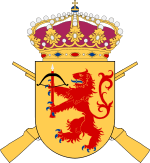Kronoberg Regiment
| Kronoberg Regiment | |
|---|---|
|
Kronobergs regemente (I 11, I 11/Fo 16) | |
 | |
| Active | 1623–1997 |
| Country | Sweden |
| Branch | Swedish Army |
| Type | Infantry |
| Size | Regiment |
| Motto(s) | None |
| Colours | Red and yellow |
| March | "Admiral Stosch" (ca 1880–1997) |
| Battle honours | Breitenfeld (1631), Lützen (1632), Wittstock (1636), Landskrona (1677), Kliszow (1702), Warszawa (1705), Fraustadt (1706), Holovczyn (1708), Helsingborg (1710), Valkeala (1790) |
The Kronoberg Regiment (Swedish: Kronobergs regemente), designations I 11 and I 11/Fo 16, was a Swedish Army infantry regiment that traced its origins back to the 16th century. It was disbanded in 1997. The regiment's soldiers were originally recruited from Kronoberg County, and it was later garrisoned there.
History
The regiment has its origins in fänikor (companies) raised in Kronoberg County in the 16th century. In 1616, these units—along with fänikor from the nearby Kalmar County—were organised by Gustav II Adolf into Smålands storregemente, of which twelve of the total 24 companies were recruited in Kronoberg County. Smålands storregemente consisted of three field regiments, of which Kronoberg Regiment was one. Sometime around 1623, the grand regiment was permanently split into three smaller regiments, of which Kronoberg Regiment was one.
Kronoberg Regiment was one of the original 20 Swedish infantry regiments mentioned in the Swedish constitution of 1634, although it was mentioned as one of two regiments that should merge to form Småland Regiment, but that regiment was never formed and instead Kronoberg Regiment and Jönköping Regiment were kept separate. The regiment's first commander was Patrick Ruthwen. The regiment was allotted in 1684. The regiment was given the designation I 11 (11th Infantry Regiment) in a general order in 1816.
Kronoberg Regiment was garrisoned in Växjö from 1920. In 1974, the regiment gained the new designation I 11/Fo 16 as a consequence of a merge with the local defence area Fo 16. The regiment was disbanded in 1997.
Campaigns
- The War against Sigismund (1598–1599)[1]
- The Polish War (1600–1629)
- The Thirty Years' War (1630–1648)
- The Torstenson War (1643–1645)
- The Northern Wars (1655–1661)
- The Scanian War (1674–1679)
- The Great Northern War (1700–1721)
- The Seven Years' War (1757–1762)
- The Gustav III's Russian War (1788–1790)
- The First War against Napoleon (1805–1810)
- The Finnish War (1808–1809)
- The Second War against Napoleon (1813–1814)
Organisation
|
|
Name, designation and garrison
| Name | Translation | From | To | |
|---|---|---|---|---|
| Kronobergs regemente | Kronoberg Regiment | 1623 | – | 30 June 1997 |
| Designation | From | To | |
|---|---|---|---|
| I 11 | 1816 | – | 30 June 1974 |
| I 11/Fo 16 | 1 July 1974 | – | 30 June 1997 |
| Training ground or garrison town | From | To | |
|---|---|---|---|
| Växjö | – | 1778 | |
| Kronobergshed | 1778 | – | 1920 |
| Gävle (G) | 1920 | – | 30 June 1997 |
See also
References
- Braunstein, Christian (2003). Sveriges arméförband under 1900-talet. Stockholm: Statens Försvarshistoriska Museer. ISBN 91-971584-4-5.
- Holmberg, Björn (1993). Arméns regementen, skolor och staber: en sammanställning. Arvidsjaur: Svenskt militärhistoriskt bibliotek. ISBN 91-972209-0-6.
- Kjellander, Rune (2003). Sveriges regementschefer 1700-2000: chefsbiografier och förbandsöversikter. Stockholm: Probus. ISBN 91-87184-74-5.
- Nelsson, Bertil (1993). Från Brunkeberg till Nordanvind: 500 år med svenskt infanteri. Stockholm: Probus. ISBN 91-87184-23-0.
- Svensk rikskalender 1908. Stockholm: P.A. Norstedt & Söner. 1908.
- Online
- Holmén, Pelle; Sjöberg, Jan (2007). "Swedish Armed Forces 1900-2000". Archived from the original on September 28, 2007. Retrieved 2007-08-20.
- Högman, Hans (2007). "Militaria - Svensk militärhistoria". Retrieved 2007-08-20.
- Persson, Mats (1998). "Swedish Army Regiments". Archived from the original on 2007-08-30. Retrieved 2007-08-20.
- Sharman, Ken (2000). "Swedish military administrative division as per 1629". Retrieved 2007-08-20.